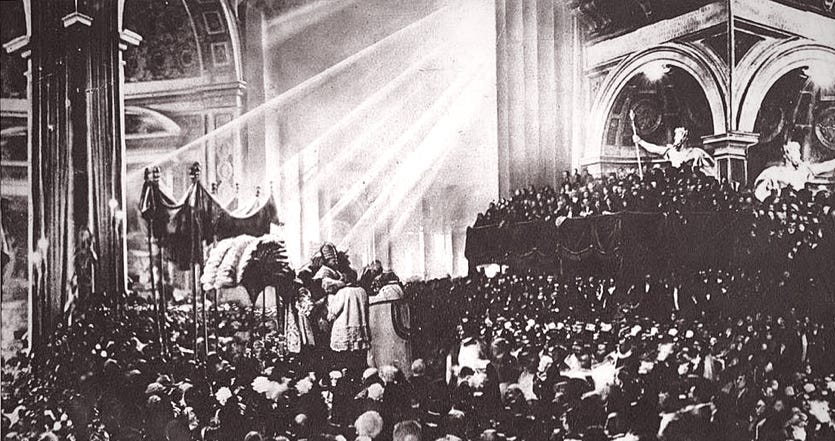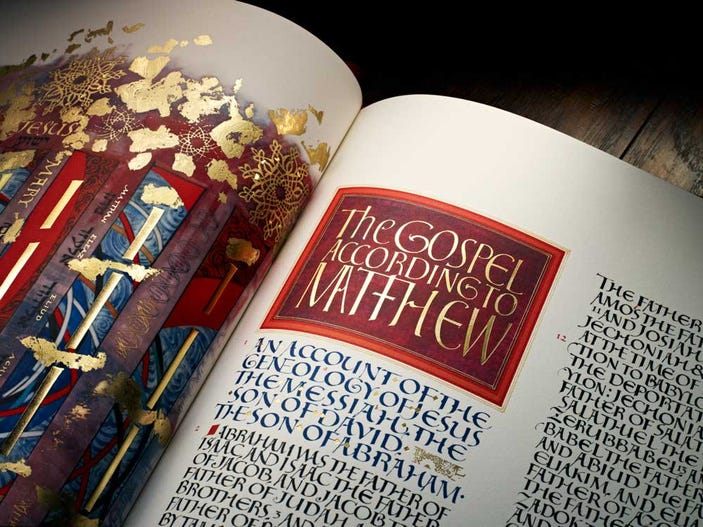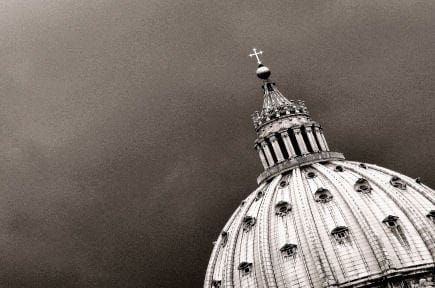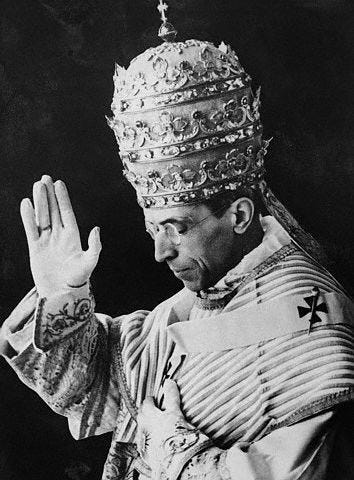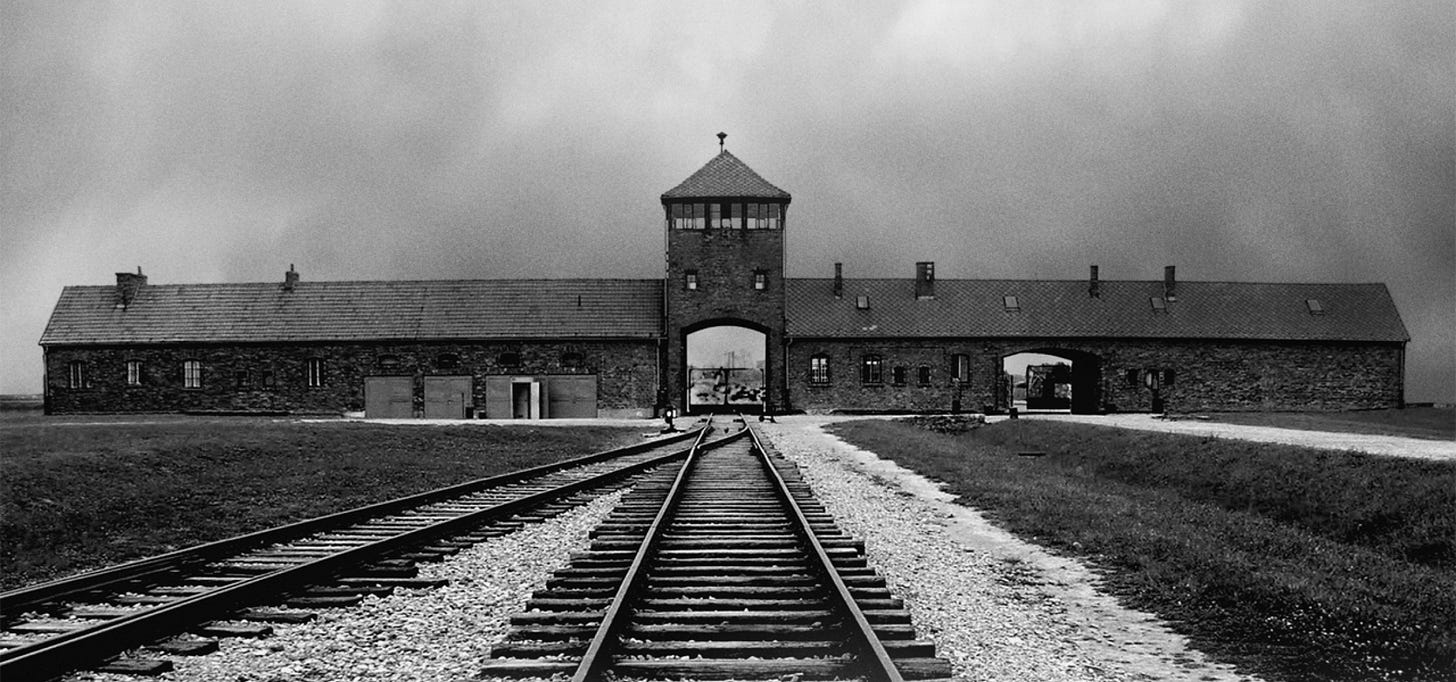(This is the second post in a series on the history of the Second Vatican Council. Additional posts can be found here: Introduction.)
The recent death of Joseph Ratzinger—formally known as Benedict XVI—brought out more backwards analysis of the Catholic Church from
at The New York Times. And it reminded me that I’d promised a series of posts on the Second Vatican Council to refute his dubious history. Part of my delay is because I’ve been waiting for Douthat to provide proof of his claims that the Council was a failure, which he said he’d give readers of his private newsletter. All he’s submitted so far is a post in which he rests his case on a single conversation with a fellow Catholic at a party. That’s it. Maybe more’s to come, but right now, his is a house built on sand.It’s tempting to respond upfront to Douthat’s latest statements about Ratzinger, which are quite tendentious. But my main point in all this is that you have to step back and take a broader view of the history of Catholicism to understand Vatican II. Only then do the dynamics of recent decades come into focus. As with any historical moment, interpreting the Second Vatican Council isn’t simple. Experiences of this scale are so complex that it takes time, distance, and various analytical tools to get a proper picture. Vatican II was an event, made by flesh and blood characters operating in a specific context and effected through a process of conflict. In other words, it was a drama. To apprehend it, we must know the players and lay the scene. For, like any great drama, it took place against an immense backdrop: nearly four centuries of historical and ecclesial developments since the last major council, at Trent.
I . Church Traumatic, Church Triumphal
When Angelo Giuseppe Roncalli became the bishop of Rome in October of 1958, the Roman Catholic Church looked from the outside to be as unshakeable, confident, and unified as its immense basilicas. It came into being with the birth of modernity itself at the start of the 16th century, when four eruptions shook the foundations of Christendom: the “discovery” of the Americas; the scientific revolution; the beginnings of capitalism; and the Protestant Reformation. These developments emerged from the Renaissance, which had been flowering in Europe for over a hundred years. Together, they transformed the continent’s political units from weak, localized fiefdoms into global empires.
At the same time, they fractured the religious and conceptual unity of the continent through a century of catastrophic wars. In these violent labor pains, a new age was born, celebrating a fresh set of virtues through the witness of Luther and the Reformers: a liberated humanistic spirit that saw the world as made for possibility; the rise of secular power over clerical; the importance religious liberty and the sanctity of conscience; the primacy of literacy so as to read the Bible; and the emphasis on one’s personal relationship with God.
Rome fought all of these movements fiercely, even as it appropriated many of their elements. But just when the church seemed to right itself by the mid-eighteenth century, the French Revolution traumatized it all over again. As James Chappel puts it in his review of John McGreevy’s new history of the church, the Revolution was the event that, “more than any other, shattered the dream of a unified Catholic society, in a uniformly Catholic Europe.” The paroxysm in France unleashed an anti-clerical spirit upon the land, championing the causes of freedom, reason, and equality. Rationalism and Liberalism—the twin philosophies of individual rights, unfettered inquiry, self-determination, and subordination of religion to the state—haunted the dreams of the popes. Worst of all these evils was democracy, the notion that people can govern themselves, untethered from ecclesial guardianship.
In response to this perceived assault, church leadership adopted a siege mentality and embarked on a muscular counter-revolution. Its campaign was marked by several related features:
Centralization. The 19th century witnessed great centralization and bureaucratization of church operations by the Roman Curia. This trend had already begun after Trent, with the establishment of a Rites congregation that imposed a previously unheard of uniformity on liturgy and worship. It published a common breviary, missal, and catechism for the first time. This was the true creation of “Roman Catholicism,” the ecclesiastical monoculturation of the church. “As a consequence,” Jesuit historian John O’Malley puts it in What Happened at Vatican II (2008), “Catholics increasingly looked to ‘Rome’ not only as a court of final appeal but for answers to all questions.” Modern communications and technology, ironically, facilitated the Vatican’s micromanaging of bishops and prelates on the local level.
Emergence of the Magisterium. Before the 19th century, the “magisterium,” or teaching authority of the church, held a modest meaning. Thomas Aquinas said that there were the magisters of the academy (theologians) and the magisters of dioceses (prelates). The bishop of Rome was not considered an authority figure on matters of doctrine, only a mere administrator. But starting in the 1830s, Pope Gregory XVI began issuing encyclicals to enforce doctrine on a universal level. These were rather short, as were those of his successor, Pius IX, who reigned until 1878. But this epistolary form of teaching was transformed by Leo XIII at the end of the century, especially in his writings on social and labor issues. Pius X, XI, and XII all followed the precedent Leo set, using encyclicals to teach theology in a normative fashion (culminating in the papacy of John Paul II, who wrote more pages of text than any pope in history). This was all new for Catholicism; whether it was healthy is an open debate. What’s certain, in any case, is that it was unquestionably a modern development.
Standardization of the Code of Canon Law. 1917 saw the promulgation of a single, universal code of canon law for the church. Prior to that, juridical disputes were dealt with according to local customs. Liturgical laws were local, too. These precedents and traditions lost influence after 1917. The code shored up and even augmented the power of the papacy, giving the pope greater control over church councils. It also abandoned the tradition of electing bishops in dioceses, granting the pope authority to appoint them himself. On the whole, it intensified the Vatican’s juridical approach to many church matters.
The Roman Question. During the mid-19th century, a series of political revolutions broke out that the papacy came to see as demonic. The Vatican, in response, asked Napoleon III of France to provide troops to protect it. When they were withdrawn, Italian nationalists occupied the city. Again, this upheaval unnerved the church, which understood temporal independence to be necessary for safeguarding its spiritual mission. The way to regain that autonomy, it became convinced—the way to be free of secular interference—was to form its own nation-state, as so many other peoples were doing at that time.
Rise of Ultramontanism. Ultramontanism—literally, “looking beyond the mountains,” i.e., beyond the Alps to Rome—describes the movement to concentrate authority in the papacy and recognize various papal prerogatives. This, too, began with Gregory XVI. The papal nuncio became not only a legate to the head of a foreign state, but the pope’s eyes and ears on the goings on of the local church. Further, under Pius IX, the customary quinquennial visits of diocesan bishops to Rome became a further way to keep tabs on things. These efforts at papal/monarchical surveillance were based on the metaphor of an organism, which needs a head and brain to coordinate and control it. The state, in this understanding, was such an organism, with the monarch as its animating nucleus. Likewise, the church, which came to be understood as a “perfect society.” And to be truly sovereign, the head of this church must also be perfect—Vatican I promulgated the notion of papal infallibility.
Along with these trends, the church also developed what McGreevy calls the Catholic milieu, or “the idea that Catholics ought to build a network of institutions that could nourish Catholic living from cradle to grave, even in a world where politics was spinning free of the Church.” This counter-society consisted of schools, hospitals, labor unions, universities, colonial missions, sodalities, and more. Infusing it was a self-understanding of the church as the Body of Christ, a militant organization divided into ranks of “clergy” and “laity,” the former devoted to holiness and separation, the latter called to labor in “the world,” obey the magisterium, and partake of the sacramental system.
II. Undercurrents
Even as the Catholic hierarchy demanded more and more authority, however, a series of developments within the church over the course of the 19th and 20th centuries challenged its bunker behavior:
Biblical Scholarship. The first was the application of new approaches to studying the Bible, what’s become known as the historical critical method. This school of thought accepted the Enlightenment (with its emphasis on reason and scientific rigor) and brought historical, archeological, and philological tools to scripture, calling into question the supernatural elements of the Gospels and trying to ground the texts in their historical, social, and literary environment.
The Liturgical Movement. The second was a movement to reform the liturgy that began in the mid-19th century, centered especially in monastic communities like the abbey at Solesmes in France. The impulse behind this reform was conservative, in fact, a reaction seeking to combat secularization by making worship—especially the Eucharist—the center of life. In the process, these reformers shed various devotional trappings that had accumulated, such as the Rosary and novenas, in order to give pride of place to the divine liturgy. This movement was part of the Romantic era’s obsession with the Middle Ages, bringing back polyphonic chant and encouraging the congregation’s participation in worship. It emphasized use of the vernacular, not Latin, to aid this activity. The movement found additional inspiration through contact with Eastern Catholics and the Orthodox, many of whom fled westward from Russia in the aftermath of 1917. Encountering the liturgy of the ancient Eastern churches—so varied and different from the Latin Mass—awakened reformers to other ways of being Catholic, and catalyzed their turn to the Patristic era for normative theology and praxis. As O’Malley puts it, “the intimate relationship between liturgy and ecclesiology [theology of the church] was becoming ever clearer: how one understood the liturgy was key to how one understood the church, and vice versa.”1
Modernism. Finally, an amorphous and broad phenomenon known as Modernism emerged around the turn of the 20th century. It’s difficult to sum up this movement, but the general conviction of its fellow travelers was an acceptance that change is pervasive and that institutions—including the church—must reckon with those changes. They sought to help the church reconcile itself with the best of intellectual culture. Modernists were skeptical of metaphysics and critical of Scholastic theology, which had atrophied into a stale Thomism. Some even saw democracy as a positive development and advocated for the political ideology of Christian Democracy. Through it, the laity—freed from the supervision of the hierarchy—would assume their rightful responsibility for the common good. Others saw Christian truth as founded not on “objective” reception of revelation, but rather on intuition and religious experiences, which were then articulated into symbols and rituals.
The deeper tides moving these various currents was the embrace of historicity and the turn to the subject in Western philosophy since Kant (and really since Descartes). The latter—which flows through such diverse schools of thought as Transcendental Idealism, Existentialism, Phenomenology, Personalism, and more—emphasizes the fundamental role that embodied consciousness plays in the constitution of reality. Meaning goes through the subject, without whose categories of perception the world doesn’t exist. Truth isn’t always already “out there,” independent of people and just awaiting our assent. Rather, it emerges through the presence and operations of transcendental consciousness, located in the particular, irreducible self. This doesn’t mean everything’s relative. But it does mean, at bottom, that appeals to some kind of deposit of beliefs divorced from the subject are inadequate and futile.
We might characterize historicity, on the other hand, as the awareness and investigation of how religious teachings and practices evolve over time, while maintaining fundamental continuity with their origins. This consciousness of the development of doctrine found its champion in John Henry Newman, the great Anglican divine, whose growing commitment to this awareness led him, ironically, to convert to Catholicism—a church that denied such historical evolution.
Historicity took off especially in the first half of the 20th century, as theologians explored the development of everything from the Thomism to church governance to the sacraments themselves. What they concluded, as the French Dominican scholar Yves Congar put it, was that the only constant in the church’s life is change! Reform—rather than an aberrant heresy—has been a healthy, recurring, and necessary feature of church life through the ages. Far from a bogeyman to fear, reform is a good to be embraced. The church is being led through history by the Holy Spirit, who renews, restores, and reconstitutes it in every generation.
III. The Perfect Storm
As you can appreciate, what we have, then, are the makings of a crisis: an irresistible force—modernity—meeting an immovable object—the Catholic hierarchy. Just as the church’s leadership was asserting greater combativeness against the present age, its intellectual and monastic quarters were entertaining the zeitgeist in exciting—or, depending on your perspective, dangerous—ways. This irrepressible conflict led to a series of clashes wherein the Vatican sought to crack down on the disquiet in the ranks.
This punitive approach began with the aforementioned Gregory XVI, who condemned freedom of speech, the press, and separation of church and state in his encyclical Mirari Vos (1832). The most pernicious evil of the day, he added, was freedom of conscience, that “shameless font of indifferentism” which “spreads ruin in sacred and civil affairs.” His successor, Pius IX, continued in this vein, promulgating the infamous Syllabus of Errors in 1864. This document condemned eighty “errors,” including the idea that Catholicism should not be the established religion of the state, and that non-Catholic immigrants to a Catholic country should be allowed to practice their own faith. It capped off this list by rejecting the notion that “the Roman Pontiff can and should reconcile himself and make peace with progress, with Liberalism, and with modern culture.”
Leo XIII took a more moderate approach in Diuturnum (1881), conceding that legitimate government can assume different forms. But he repeatedly condemned the proposition that authority in the state derives from the will of the people and not God. Au Milieu, eleven years later, again denounced separation of church and state as an “absurdity.” In Providentissimus Deus (1893), the pope rejected the new methodology in biblical scholarship and founded the Pontifical Biblical Commission to shield the Word of God “not only from every breath of error but even from every rash opinion.”
The election of Pius X in 1903 witnessed the pontiff condemning religious liberty yet again and reiterating the hierarchical structure of the church. On July 3, 1907, the Holy Office issued the decree Lamentabili, which denounced sixty-five propositions supposedly held by Modernists, including the idea that marriage evolved as a sacrament late in Christian history (true) and the very idea of ecclesial reform itself (beneficial). The pope followed up this decree two months later with Pascendi Dominici Gregis, which labeled Modernism a heresy that rested on two false principles: the rejection of metaphysical reason and the denial of supernatural revelation. Along the way, he denounced the notion that doctrine evolves and that the laity should participate in church governance.
The encyclical prescribed harsh remedies for such contagion amounting to wholesale persecution and punishment of supposed Modernists. Anyone “imbued” with this heresy, as well as anyone found “criticizing Scholasticism, the Holy Father…or showing a love of novelty in history, archaeology, biblical exegesis,” and so forth, were to be excluded “without compunction” from all teaching posts. Bishops were to censor publications in their dioceses and drive out “any pernicious books” from shops. Priests were forbidden to gather for meetings, since that was how Modernism spread, except when they had the bishop’s express permission. Each diocese was to establish a “Vigilance Council” to inform the bishop of anything or anybody tainted with the heresy. Bishops were to submit a report every three years documenting the implementation of these policies. Finally, Pius made all clerics, especially philosophers and theologians, swear an oath to uphold these provisions (which was abrogated only in 1967). O’Malley sums the document up thus:
For the sweep of its accusations, the accusatory style of its language, and especially the severity of its provisions, Pascendi had few, if any, precedents in documents emanating from the papacy. A veritable purge followed…The definition of Modernism was so general, virtually equated with “any novelty,” that it could be applied to almost any work of any philosophical or historical school. Excommunications, dismissals from office, and banning of books reached epidemic proportions.2
Pius XI, who reigned from 1922 to 1939, eased this approach somewhat, but he, too, offered proscriptions of great consequence. First, in 1928 he condemned the ecumenical movement underfoot—the dialogue between the various Christian churches—with Mortalium Animos. In this encyclical, he stated that it was unlawful for Catholics to support such a movement or even attend non-Catholic religious services. It further forbad “any intercourse with those who professed a mutilated and corrupt version of Christ’s teachings.” Rather, he called on the “dissidents” to return to the one, true church.
Second, with Casti Connubii (1930), he absolutely condemned all forms of artificial birth control and the “pernicious errors and depraved morals” of his age. Married couples who engaged in such family planning offended “the law of God and of nature,” and were “branded with the guilt of a grave sin.” The language was so severe that some theologians interpreted it as an infallible decree.
The Pian Era reached its apotheosis with Eugenio Pacelli, Pius XII. During his long reign (from 1939 to 1958), this pontiff issued some forty encyclicals. Four were important for the events of Vatican II. First, in Divino Afflante Spiritu (1943), he expressed approval for the literary, linguistic, and historical methods of biblical scholarship, which Leo XIII had denounced. That same year he published Mystici Corporis, which identified the Mystical Body of Christ with the Roman Church and insisted that membership in that church was restricted to those baptized in it and who were in communion with the pope. A follow-up statement clarified that salvation was not possible for anyone outside the church, except by “implicit desire” to join Catholicism. Thirdly, with Mediator Dei (1947) he gave his blessing to the Liturgical Movement and even undertook some of his own basic reforms in this arena.
The generally positive tone of these documents was smashed, though, by Humani Generis in 1950. Here Pius issued a relentless condemnation of “false opinions” and “novelties” that threatened the church. It seemed to step back from his previous warm attitude towards promising intellectual developments, replacing it with an accusatory voice that defended Thomism with a vengeance. It denounced Modernism yet again, and enumerated a series of errors being floated in academic circles.
While Pius didn’t name names, the leaders of various religious orders immediately took action against offenders in their midst. In the aftermath of the encyclical, theologians like Henri de Lubac, Yves Congar, Marie-Dominique Chenu, and others were removed from their teaching posts and banned from publishing. From 1951 onward, German Jesuit Karl Rahner, too, was repeatedly censored and forbidden to publish.
These moves signaled a draconian final phase to Pius’s reign. In 1952, the Holy Office warned against using modern art in churches. The following year it nearly condemned the novel The Power and the Glory by Graham Greene—one of the greatest modern authors and a Catholic—for the crime of having a whisky priest as its protagonist. Graham Greene! Three years later, American Jesuit John Courtney Murray was banned from writing about church-state relations, and French philosopher Jacques Maritain came under scrutiny for sharing similar views. The Jesuit scientist and mystic Pierre Teilhard de Chardin was also forbidden to publish his works, and after they were posthumously disseminated by his executor, the Holy Office declared, in 1962, that they were filled with grave errors.
All of these actions—many of them carried out by the imposing Cardinal Alfredo Ottaviani of Italy—engendered bitter resentment on the part of theologians and even bishops. The latter felt Rome was overstepping its bounds and issuing heavy handed orders. And the autocratic style of punishment was not appreciated by the former, to say the least. In ways discreet and sometimes open, people pushed back. But the juridical, militant, condemnatory style of the hierarchy showed little signs of abating. O’Malley sums up the state of affairs thus:
In the 1950s, therefore, behind the placid facade that Catholicism presented to the world, a clash of epic proportions was waiting to happen.3
IV. The Breaking Point
Another epic clash helped form the backdrop of the Council, and we must conclude with its shadow in view. Six months after Pacelli became pope, the Second World War commenced, the final act of the 20th century’s thirty-years conflagration. The war brought ruin to Europe and death to untold multitudes. It also released titanic changes in the decades after, marked by astonishing technological innovations (rockets, computers, the Bomb) and cultural transformations (sex, drugs, rock n’ roll). Political turmoil rocked the planet, too, with the globe divided between two ideologically opposed superpowers—the Soviet Union and the United States—locked in an existential death match.
Moreover, the awareness that humanity now had the power to wipe out all life from the Earth sparked the dawning of a new consciousness of man’s destiny. The space age spawned fresh questions about our place in the universe and God’s very existence. A renewed global community emerged, symbolized by the United Nations, hoping for an era of goodwill and brotherhood after centuries of division. Even as colonial wars continued to plague the planet, the liberation of the Global South from the yoke of empire signaled the arrival of voices that had previously been shut out. Millions were Catholic, though of very different complexions.
In short, more change had occurred in a few decades than humanity had witnessed in the preceding two millennia. No institution could hide from these seismic shifts any longer—not even the Catholic Church. Shouting them away would be as effective as the pope’s bull against the comet. The question, then, was whether the church would continue to resist the tide and condemn itself to extinction, or sail in concert with it and risk being swept dangerously off course?
There’s one final factor we must consider, the most profound of all. Amidst the immense suffering and loss of the war, a singular disaster lay at its core: the mass murder of 6 million Jews by the Nazi regime. Despite the righteous actions of many individual Catholics, the failure of the church as an institution to stand against this unspeakable crime—and its long history of anti-Jewish hatred—haunted it in the aftermath, and still does. There’s little room left for debate about the response of Pius XII to Hitler’s war. The recent opening of the Vatican archives has allowed historian David Kertzer to shed damning new light on the pope’s passivity and even cooperation with the German jackboot, as Tim Parks related in The New York Review of Books last October.
In the face of the greatest evil in modern history, the “one, true church” fled like the disciples from the cross. Its siege mentality had led it to abandon Christ’s own people in the hour of their crucifixion, out of a craven ploy for self-preservation. The war, its genocide, and the shame of this unconscionable complicity was only beginning to be reckoned with by 1960. If nothing else, the agony of these events was causing many to rethink the church’s relationship with everything: with God, with others, with itself. It wasn’t that the world was making it harder to be Catholic (as Douthat claims). It was that the Catholic Church was making it impossible to be human, especially for its brightest minds. The suffocating atmosphere was intolerable. The Spirit had to be poured out anew. Enter Roncalli.
John W. O’Malley, What Happened at Vatican II (Cambridge: Harvard UP, 2008), 73.
O’Malley, 70.
O’Malley, 89




